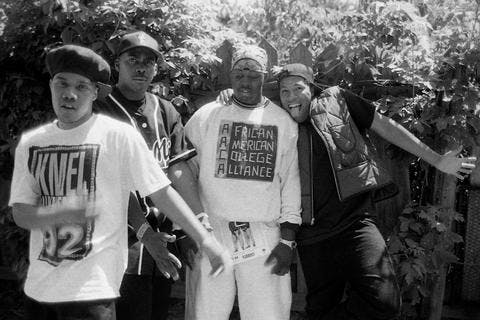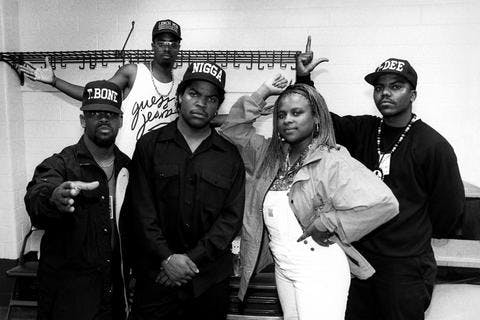
The Legendary Rappers Who Discovered Future Legends
The Legendary Rappers Who Discovered Future Legends
By Soren Baker
Published Tue, August 11, 2020 at 9:14 AM EDT
A mid-1980s trip to New York opened Ice-T’s eyes. Then based in Los Angeles, he had traveled to Manhattan to get a record deal and ended up getting much more, namely a new perspective on how rap could operate.
“Once I was in New York, I got put on by the Zulu Nation, Afrika Islam, Bam[baataa], and all of them,” Ice-T says. “I was interested in the way the Zulu Nation operated. Basically the Zulu Nation was a group of groups with a common goal, which was Hip-Hop. And I dug it. I dug the fact that the New York groups weren’t fighting. I dug the whole philosophy, but I knew that Zulu was a little too Afrocentric for LA because LA was on the gang tip. So I modeled [my Rhyme] Syndicate after what [New York gangster] Lucky Luciano created called The Commission, which was a bunch of mob families that agreed to sit down before they would beef.”
Ice-T adopted an approach in which he wanted to see other artists succeed. “I’m not competing with anybody,” says Ice-T, who became the first West Coast rapper to sign a deal with a major label when he inked with Sire/Warner Bros. in 1986. “It was just a whole bunch of people in LA that really were very, very talented. I could just tell they were talented, from DJ Aladdin to King T to DJ Pooh. There’s so many different people that were around, but I was just the first to jump off. So instead of just being like, ‘Fuck it. I’m the star,’ I’m like, ‘Look, if I can make it, I’m going to try to help you guys.’ When I got to Warner Bros. and I got my foot in the door and I had a couple of gold records, I was able to do a Syndicate album.”
Rhyme Syndicate’s 1988 LP Comin’ Through gave artists such as Low Profile (W.C. and DJ Aladdin), Everlast (of House of Pain), Toddy Tee (of “Batterram” fame), and Tim Story (director of Barbershop, Fantastic Four, Think Like a Man, Ride Along, Ride Along 2) their first national exposure in the major label system. Ice-T was also able to get major label deals for Everlast with Warner Bros., and Divine Styler and Donald D with Epic.
“My whole agenda was to create a West Coast movement of rappers, to get as many people on their feet as possible,” Ice-T says. “It was the opposite of, ‘I want to be the biggest star, the only person.’ To try to go up against the country with one group, or one person, that’s a daunting task.”

EPMD had a similar mentality. Like Ice-T, Erick Sermon and Parrish Smith sought originality in their protégés. Few rap groups were more distinctive than Das EFX.
The duo of Drayz and Skoob were discovered by rap titans EPMD at a talent showcase at Virginia State University, where Drayz and Skoob were attending. Das EFX joined EPMD’s Hit Squad unit, which also included K-Solo and Redman, and became platinum superstars and trendsetters because of their distinctive rhyme style, accented by adding “ity” to the ends of words and infused with nursery rhymes and other random pop-culture references.
EPMD’s blessing was a massive conduit to getting in the door for Das EFX. “That was basically the stamp of approval for us,” Drayz says. “They didn’t have a long track record for putting out or breaking artists at that moment, at that time. But what they did have was a string of gold albums. They were one of the greats, so for them to have put the stamp on us, at least half the battle was won.”
Around the same time on the West Coast, Ice Cube had left N.W.A and was rising to superstardom as a solo artist and actor in the early 1990s. He introduced his Da Lench Mob collective of artists on his debut LP, 1990’s AmeriKKKa’s Most Wanted, and showcased his protégé Kam on “Color Blind,” a track from his second album, 1991’s Death Certificate. The following year, the politically driven Kam released his single “Peace Treaty,” which celebrated Los Angeles’ 1992 gang truce, on Ice Cube’s Street Knowledge and EastWest Records, a division of Atlantic Records.

Kam was well aware of the impact Ice Cube had on his career. “I definitely got a boost by coming in the game through him,” Kam says. “[EastWest Records] valued his word. At that time, anything that he touched was golden.
Label heads didn’t know what was hot and what wasn’t. So they felt that if he says it’s hot and he’s putting that kind of stamp on it, then it must be that. He had me bypass all the other little procedures and processes that that artist would have to go through.”
Like Ice-T, Ice Cube was drawn to originality. But Ice Cube’s lens was more focused stylistically when it came to his protégés, a remarkable list of artists that included Yo Yo, Da Lench Mob, Del the Funky Homosapien, as well as Kam.
“It all had to do with street stuff,” Kam says. “That’s why it was called Street Knowledge. His image was a street image, so all of them had to do with representing different aspects of Los Angeles or West Coast street life. He saw the value in that, which was anti-establishment. Ghettos manifested themselves in all kinds of different ways, so he knew there was value and financial value in being able to find talent that represented their perspective or paradigm of the streets that they came from.”
As rap became increasingly more popular, it remained a street-driven and street-centered art form. A long-gestating crew of New York artists were ready for their time. RZA and his childhood friends and relatives famously formed the Wu-Tang Clan, which exploded in popularity in 1993 thanks to its landmark Enter the Wu-Tang (36 Chambers) LP and “Protect Ya Neck,” “Method Man,” and “C.R.E.A.M.” singles.
RZA produced material for every member, tailoring music to the personality of each one. “I had the most time with everybody,” RZA says. “I’m like the common denominator between the Wu. Some of the Wu didn’t know each other, but they all knew me. Me and Meth had been making demos since Meth was 14 years old. Me and Dirty were making demos since we were kids. Me and GZA have been bonded for life. We’ve been making demos and making songs since 13, 14 years old. With Raekwon, we were doing demos at 11, 12 years old. So I was blessed with the knowledge of who they were and who they are as artists. With Ghostface, we probably did our first demo at 15, 16. We were roommates since we were 18. By the time we’re the Wu, we’re 23 years old and I know these brothers well. The funny thing is that I had already prepared a lot of the albums [we did] by knowing so many of the demos we made.”
Eazy-E, Dr. Dre, Diddy, Lil Wayne, and Rick Ross are among the other artists from different rap generations to introduce some of the genre’s most popular and best talent, including Bone Thugs-N-Harmony, Snoop Dogg, The Notorious B.I.G., Drake, and Meek Mill, respectively. When artists worked with emerging talent, the music clearly benefitted.
“If I saw somebody else with talent, I’m like, ‘I’d much rather be friends with you than enemies,’ ” says Ice-T. “Why be enemies? I’m not competitive like that.”
* HEADER CREDIT: Mack 10, Ice Cube and WC of Westside Connection visit "Yo! MTV Raps" on November 28, 1996 in New York City. (Photo by Al Pereira/Getty Images/Michael Ochs Archives).



